- 1 day ago
- 24Minutes
- 5034Words
- 493Views
Up until about 10 years ago, no research existed to counter the skepticism around alkaline diet trends. However, since then, a growing body of research has documented not only that “acidosis” is a real phenomenon, but that it is now known to contribute to a wide range of diseases, such as metabolic syndrome (weight gain), cancer, osteoporosis, kidney stones, and increased susceptibility to environmental toxins, and new research is adding to the list. (28)
Acid is just like rust! It’s insidious and it eats away at you causing all kinds of problems. But what causes acid and how can you get rid of it?
In this article, we will answer these questions and share a practical way for you to keep acid under control.
Can you become acidic?
Skeptics of Natural Medicine often say “You can’t alkalize your body because your body can not become acidic” This is absolutely false. What they should say is “Your body will not let the blood become acidic” We simply could not survive with acidic blood (acidemia), but this, unfortunately, leaves the rest of the body tissues at risk (acidosis). The fact is that many common ailments we suffer from today can be the result of excess acid-forming properties of food and a build-up in body tissues. These include:
- Acid Reflux
- Arthritis, Back and Muscle Pain
- Cancer
- Cardiovascular Disorders
- Diabetes
- Gout
- High Blood Pressure
- Kidney Stones
- Metabolic Syndrome (weight gain)
- Stunted Growth
- Osteoporosis, OsteoArthritis
There are two major organ systems that help maintain the pH (acid-alkali balance) in our blood, the Kidneys, and the Lungs. They work closely together and use a number of complex chemical exchange systems to do that, which we won’t go into in detail in this article. Suffice it to say, if the lungs or the kidneys can’t keep up with the acid load in the body, we begin to accumulate acid.
What we will discuss on this page is:
- How does an acid diet cause weight again
- The types of acidosis and their negative effects
- How the organs can become compromised and unable to perform their alkalizing task
- What you can safely do to alkalize your body with diet and herbs
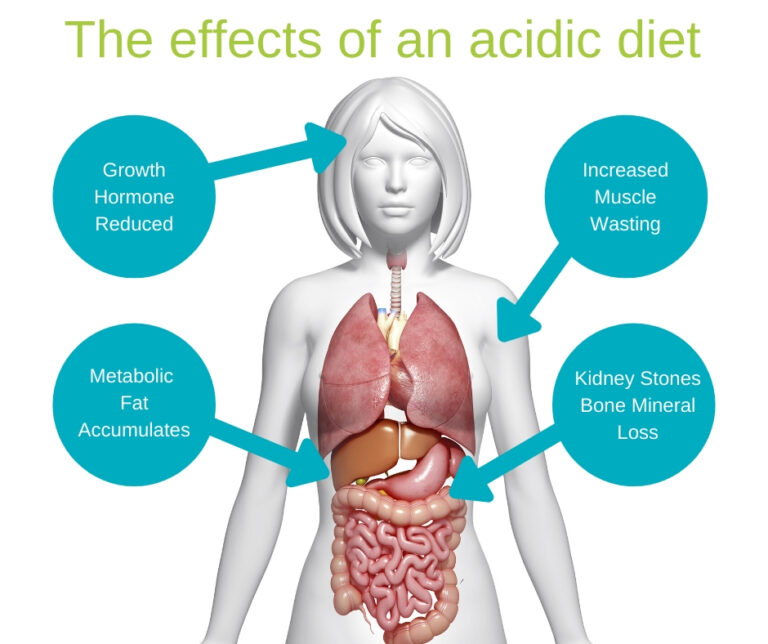
How does an acidic diet cause us to gain weight?
There are a number of reasons why a high protein (acid-forming) diet is not ideal for weight loss.
Metabolic Syndrome (Abdominal weight gain)
Recently, the role of diet-related low-level metabolic acidosis in the development of metabolic disorders including metabolic syndrome, diabetes, and heart disease has been suggested by numerous researchers highlighting the triggering effects of Western dietary patterns. Metabolic syndrome and obesity are clearly associated with impaired acid-alkaline balance in the diet. (30)
Muscle Wasting
As we age, there is a loss of muscle mass, which may predispose us to falls and fractures. A three-year study looking at a diet rich in potassium, such as fruits and vegetables, as well as a reduced acid load, resulted in the preservation of muscle mass in older men and women. Conditions such as chronic renal failure that result in chronic metabolic acidosis result in an accelerated breakdown in skeletal muscle. Correction of acidosis may preserve muscle mass in conditions where muscle wasting is common. (29)
This retention of muscle mass is a critical factor when it comes to weight loss, as no amount of fasting, calorie counting or exercise will enable you to lose weight if your body is acidic and you’re unable to retain muscle mass.
Growth Hormone
It has long been known that severe forms of metabolic acidosis in children, such as renal tubular acidosis, are associated with low levels of growth hormone with resultant short stature. Correction of the acidosis with bicarbonate or potassium increases growth hormone significantly and improves growth.
The use of enough potassium bicarbonate in the diet to neutralize the daily net acid load in postmenopausal women resulted in a significant increase in growth hormone, improving growth hormone levels may improve quality of life, reduce cardiovascular risk factors, improve body composition, and even improve memory and cognition. As well this results in a reduction of urinary calcium loss equivalent to 5% of bone calcium content over a period of 3 years. (29)
In other words, an alkaline diet increases the growth of muscle and bone, making it a lot easier to exercise and to lose weight.
Learn more about how an acidic diet affects your health, and how to avoid it below.
Acid Forming Foods
Diet can markedly affect the acid-base status and it significantly influences chronic kidney disease and its progression. (13)
Meat – Generally speaking, the foods which have the highest dietary acid load include cheese, meat, eggs, and grains. (13) Meat – Increases uric acid in the blood which can lead to gout (24). Animal foods including meat, fish, egg, chicken, cheese and also cereals are rich in sulfur-containing amino acids, phosphorous and chloride are potentially acid formers; while vegetables and fruits high in malate, citrate, and glutamate are potentially base formers, therefore, animal based-foods and high contents in western diets are potentially considered as most important acid-producer diets and are associated with a higher risk of insulin resistance, high blood pressure, and diabetes as established in numerous works. (30) Going vegetarian can greatly reduce the acid load in your body. (12)
Salt – There is evidence that in healthy humans the increased sodium in the diet can predict the degree of metabolic acidosis when consuming a net acid-producing diet. Excess dietary sodium has been shown to result in hypertension and osteoporosis in women. (12) Sodium chloride is reported to be an independent and causal factor for inducing metabolic acidosis in a dose-dependent manner (17). Added salt is in many processed foods, so avoiding processed foods and only using unprocessed salt is worth considering.
Alcohol – Since antiquity, alcohol consumption has been linked to gout. More formal research from the 1960s demonstrated that alcohol administration caused decreased uric acid excretion and hyperuricemia. (20)
Other acid-forming foods include sugar, saturated Fats, meat, coffee, and cheese. Acidogenic dietary intake such as high protein consumption can have an immediate effect on increasing net acid production while low protein lactovegetarian consumption can result in significantly reduced net acid excretion. (17)

Alkaline diet foods
Alkaline diets may result in a number of health benefits as outlined below:
- Increased fruits and vegetables in an alkaline diet would improve the K/Na ratio and may benefit bone health, reduce muscle wasting, as well as mitigate other chronic diseases such as hypertension and strokes.
- The resultant increase in growth hormone with an alkaline diet may improve many outcomes from cardiovascular health to memory and cognition.
- An increase in intracellular magnesium, which is required for the function of many enzyme systems, is another added benefit of the alkaline diet. Available magnesium, which is required to activate vitamin D, would result in numerous added benefits in the vitamin D apocrine/exocrine systems.
- Alkalinity may result in an added benefit for some chemotherapeutic agents that require a higher pH. (12)
- Alkali–producing fruit and vegetables may, therefore, contribute to a reduction in lean tissue mass in older adults. (15) Alkalizing foods largely include Fruit and Vegetables – A three-year study looking at a diet rich in potassium, such as fruits and vegetables, resulted in the preservation of muscle mass in older men and women (12)

What is Acid?
When chemical reactions in your body release pure Hydrogen atoms they are classed as acid-forming reactions. Hydrogen atoms (ions) rip apart everything they touch, just like oxygen causes rust oxidation.
It’s the same principle. All living things depend on water. Life consists of a highly complex series of chemical reactions occurring in aqueous media. Among the most important factors in the composition of these fluids are the concentrations of hydrogen ions and hydroxide ions, which determine the acidity or alkalinity of the fluid.
The maintenance of suitable concentrations of these ions is called acid-base homeostasis (acid balance). (17) The body has several lines of defense to accommodate surplus acid or base. The extracellular fluid, the contents of the cells, and the bone all provide chemical buffering. A buffer is a system of chemicals that combines with an excess of hydrogen ions or hydroxide ions. Buffering, therefore, tends to stabilize the hydrogen ion concentration. It minimizes changes but does not alter the total acid or base load in the body.
The final disposal of surplus fixed acid or base may be via metabolic pathways in the body, as described for lactic acid in the healthy exercising person. If such mechanisms are not available, then the excess acid or base must be expelled from the body, via the lungs and kidneys (17)
What does pH actually mean?
pH is a figure expressing the acidity or alkalinity of a solution on a logarithmic scale on which 7 is neutral, lower values are more acid, and higher values are more alkaline. (16) If you want to attempt to resolve any of the health issues above then trying an alkaline diet plan could be worthwhile.
Click here to see the FDA’s food pH Chart
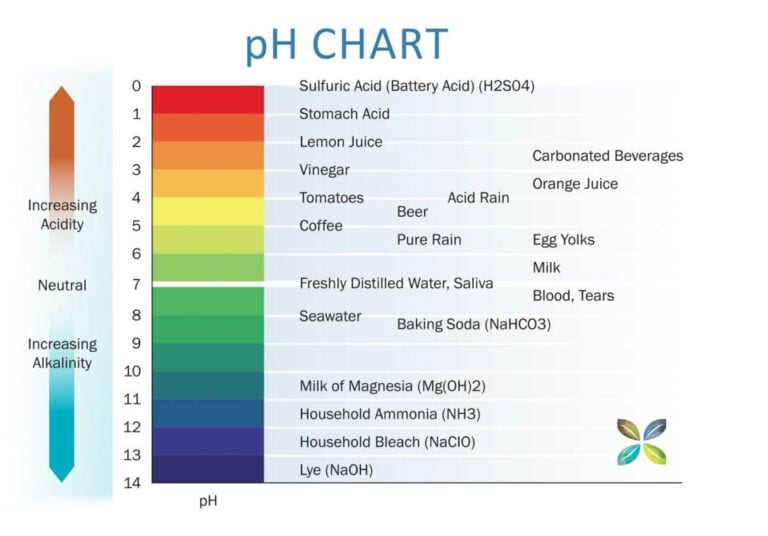
Understanding Acidosis
Life on earth depends on appropriate pH levels in and around living organisms and cells. Human life requires a tightly controlled pH level in the serum of about 7.4 (a slightly alkaline range of 7.35 to 7.45) to survive.
Even the pH of the soil in which plants are grown can have a considerable influence on the mineral content of the food we eat. (12) Acidosis is a condition in which there is too much acid in the body fluids. It is the opposite of alkalosis (a condition in which there is too much base in the body fluids). (9)
It is generally accepted that agricultural humans today have a diet poor in magnesium and potassium as well as fiber and rich in saturated fat, simple sugars, sodium, and chloride as compared to the pre-agricultural period.
This results in a diet that may induce metabolic acidosis which is mismatched to the genetically determined nutritional requirements. With aging, there is a gradual loss of renal acid-base regulatory function and a resultant increase in diet-induced metabolic acidosis while on the modern diet. (12)
It would be prudent to consider an alkaline diet to reduce morbidity and mortality of chronic disease that is plaguing our aging population. (12) We will discuss this further below. First, let’s look at the two major types of chronic acidosis.
Chronic Respiratory Acidosis
Respiratory acidosis develops when there is too much carbon dioxide, and, therefore, acid builds up in the body. This type of acidosis is usually caused when the body is unable to remove enough carbon dioxide through breathing. (9)
The inability of the lungs to perform their job of gas exchange is the primary reason for respiratory acidosis. Obstructive mucous and pollution combined could severely disrupt the lungs. Chronic obstructive pulmonary disease (COPD) is a major public health problem. Its prevalence varies according to country, age, and sex.
On the basis of epidemiologic data, the projection for 2020 indicates that COPD will be the third leading cause of death worldwide and the fifth leading cause of disability (5) Even though the overall prognosis of COPD patients is lately improved, the mortality rate remains high, and acid-base disorders occurring in these subjects can affect the outcome.
Clinical and epidemiological data clearly demonstrate that the severity of acidosis is associated with poor prognosis. (5) Considering the worldwide problem with air pollution this chronic acidosis problem is likely connected with chronic lung diseases such as COPD and asthma, not to mention that most of us only breathe 1/3 of our lung capacity.
During exhalation, carbon dioxide produced by cellular respiration is projected into the environment. In the human body, carbon dioxide combines with water via carbonic anhydrase and forms carbonic acid which dissociates into a hydrogen ion and bicarbonate. This is why a reduced respiratory rate will lead to a decreased pH; the more carbon dioxide is exhaled, the less carbon dioxide present for this reaction. (31)
Respiratory acidosis as a primary disorder is often caused by hypoventilation. This can be due to multiple causes including chronic obstructive pulmonary disease, opiate abuse/overdose, severe obesity, and brain injury. (31)
Deep Yogic meditative breathing is a great way to reduce the acidosis caused by insufficient breathing, which occurs when we are under stress.

Chronic Metabolic Acidosis and Kidney Function
Your kidneys play a major role in regulating the pH of your blood. Their major role is to eliminate acids from your blood along with other wastes and toxins. Metabolic acidosis develops when too much acid is produced in the body and the kidneys cannot keep up with the demand, and are unable to remove enough acid from the body. (9)
If your urine starts to smell strong or you get aching kidneys then you may be suffering the beginnings of low-grade metabolic acidosis affecting your kidneys. Gout and kidney stones are also signs of chronic acidosis. See more on this below.
Chronic metabolic acidosis is a process whereby an excess acid load is chronically placed on the body due to excess acid generation or diminished acid removal by normal homeostatic mechanisms.
Two common, often-overlooked clinical conditions associated with chronic metabolic acidosis are aging and excessive meat ingestion. (1) Because the body’s homeostatic response to these pathologic processes is very efficient, the serum HCO3− (acid buffer) and blood pH are frequently maintained within the “normal” range.
Nevertheless, these homeostatic responses engender pathologic consequences, such as nephrolithiasis (kidney stones), bone demineralization, muscle protein breakdown, and renal (Kidney) growth. (1) A low-carbohydrate high-protein diet with its increased acid load results in very little change in blood chemistry, and pH, but results in many changes in urinary chemistry.
Urinary magnesium levels, urinary citrate, and pH are decreased, urinary calcium, undissociated uric acid, and phosphate are increased. All of these result in an increased risk for kidney stones (12)
Uric acid
Uric acid is a product of the metabolic breakdown of purine nucleotides (which come from meats), and it is a normal component of urine. High blood concentrations of uric acid can lead to gout and are associated with other medical conditions including diabetes and the formation of ammonium acid urate kidney stones.
Gout
Gout is one of the most common inflammatory arthritides, caused by hyperuricemia (elevated uric acid in the blood), with an increasing prevalence. Hyperuricemia is often a consequence of renal under-excretion of uric acid. Data has demonstrated increased uric acid levels in association with greater meat and seafood consumption, while a comparison of alcoholic beer to nonalcoholic beer found that plasma uric acid levels increased by 6.5% and 4.4% respectively. (20)
Whether or not fructose itself is the responsible component for hyperuricemic effects of sugar-sweetened beverages is debatable. However, current data suggest that heavy utilization of these food items is not advisable for those at risk of hyperuricemia and gout. (20)
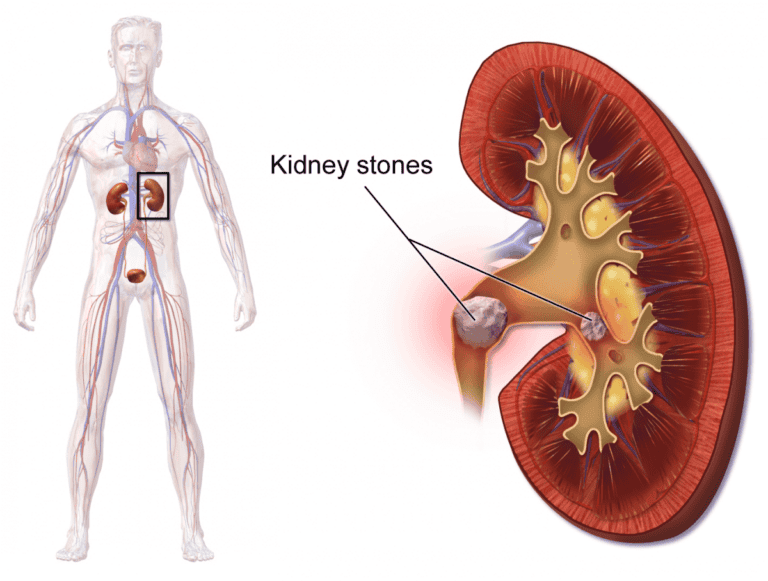
Kidney Stones and Alkaline Diet
The body of evidence suggests that the incidence and prevalence of kidney stones are increasing globally. These increases are seen across sex, race, and age. Changes in dietary practices may be a key driving force. (10) The consumption of fast foods and high fructose corn syrup preparations has been thought to promote this epidemic.
In the United States alone, the percentage of meals coming from fast-food eateries or restaurants rose from 9.6% to 23.5% during the timeframe of 1977 to 1996. (10) Increased consumption of starchy foods promote obesity, currently a known risk factor for stone formation. (10)
The inflammation connection
Normal human subjects have demonstrated that only about one-half of a mineral acid load is buffered in the extracellular space and red blood cells. The remaining hydrogen ions exchange with sodium and potassium from tissue and bone and are presumably buffered in these areas. Van Slyke and Cullen first observed that total blood volume could account for the buffering of only one-sixth of a mineral acid load and suggested that buffer substances throughout the body, including those of the tissues, are utilized in the defense against metabolic acidosis. (27)
This means that our body tissues can be responsible for dealing with the other five-sixths of the metabolic acid load. Chronic acidosis will put the body into a constant state of inflammation and this inflammation underlies our most common chronic diseases. Higher levels of inflammatory biomarkers are associated with increased mortality and the development of chronic disease.
A recent study reported that all-cause mortality increased by 11% for every increase in leukocyte count. Other studies also reported a significant relationship between mortality and markers of inflammation. A higher leukocyte count, C-reactive protein level and mean platelet volume predict the development of cardiovascular disease and cancer. (21)
Existing studies linking acidosis to inflammation have generally examined the impact of acute large reductions in extracellular pH. However, chronic small reductions in pH affect a variety of physiologic processes and may have a substantial impact on inflammation and the development of chronic disease. (21)
It is now recognized that a mild pro-inflammatory state is correlated with the major degenerative diseases of the elderly. The inflammatory mediators increase with age in both women and men and are highly correlated with obesity and degenerative disease. (22)
Bone Density Decreases (Osteomalacia)
One study clearly showed chronic metabolic acidosis induces bone mineral dissolution. (2) An over-acidic diet will cause the bone matrix to dump calcium increasing calcium elimination via the kidneys.
Bone citrate and carbonate are mobilized to neutralize these acids, so urinary calcium increases when dietary protein increases. (23) Age-related decline in kidney function, with its associated trend towards metabolic acidosis, would be sufficiently important to accelerate bone resorption while reducing bone formation, and thus could eventually explain the increased incidence of osteoporotic fractures with aging. (11)
Considering the epidemic of kidney stones (connected with dietary habits) and age-related kidney function decline, you can clearly see how an acidic diet could play a major role in many cases of metabolic acidosis and osteoporosis.
Tissue Acidosis Causes Pain
Tissue acidosis appears as a dominant factor in inflammatory pain. (6) One study investigated the role of local acidosis in the generation of pain in complex regional pain syndrome. It was demonstrated that acidic fluid causes pain, not only restricted to the skin but it also generated in deep tissue pain of the affected limb. (7) Results of another study demonstrate muscle acidosis can lead to local and referred pain (8)
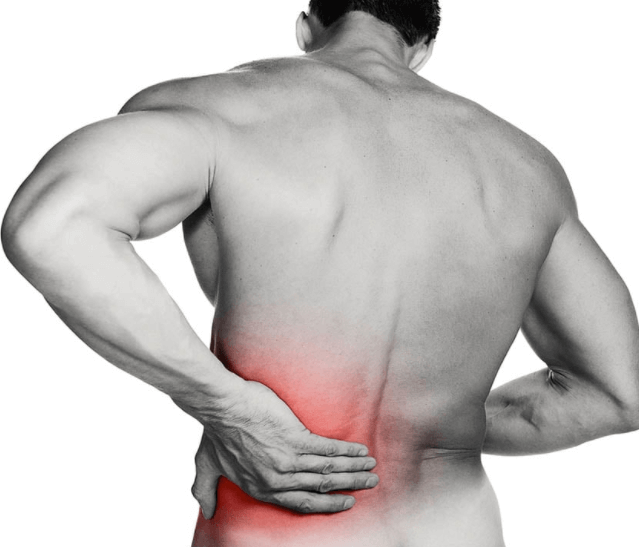
Acidosis and Arthritis
Metabolic acidosis, where the body has an excess of acid or a significant decrease in bicarbonate, can have various impacts on the body, including potentially influencing arthritis. Here’s a breakdown of how these two might be linked:
- Calcium Mobilization
Chronic metabolic acidosis can lead to the mobilization of calcium from bones to buffer the excess hydrogen ions in the blood. This calcium loss can weaken bones, potentially exacerbating conditions like osteoarthritis, where joint damage is often coupled with changes in the bones. - Increased Inflammation
Metabolic acidosis might increase levels of inflammation in the body. Inflammation is a key factor in many forms of arthritis, including rheumatoid arthritis. Increased systemic inflammation can exacerbate the inflammatory processes already present in arthritis, leading to more severe joint damage and pain. - Effect on Connective Tissue
The acidic environment may alter the properties and functioning of connective tissues. Collagen, which is vital for the structural integrity of cartilage and connective tissue in joints, may degrade faster in more acidic conditions, potentially accelerating the degenerative process seen in arthritic joints. - Impaired Muscle Function
Acidosis can impair muscle function and exacerbate muscle wasting. Weaker muscles can put more strain on joints, worsening symptoms of arthritis, particularly in weight-bearing joints like the knees and hips.
Cancer And Alkaline Diet
Acidity is a well-known factor associated with cancer. Lower pH levels in the extracellular space promote the invasive and metastatic potential of cancer cells. (18) Persistent acidic diets have the potential to cause small decreases in blood pH, but not beyond the normal physiological range.
This condition is described as ‘diet-induced’, ‘low-grade’, or ‘chronic metabolic acidosis’ or sometimes ‘latent acidosis’. Diet-induced acidosis is distinct from clinical metabolic acidosis in that clinical metabolic acidosis occurs when factors other than just acidic diet contribute a system’s inability to compensate for low blood pH. (18)
Acidosis-associated insulin resistance through cortisol activity may result in compensatory pancreatic insulin secretion and higher levels of circulating insulin in the serum, a condition known as hyperinsulinemia. Epidemiology studies have shown a positive correlation between circulating insulin levels and increased risk and pathogenesis of colorectal and pancreatic cancers, cancers of the endometrium, kidney cancer, and breast cancer. (18)
It is generally understood that the cancer condition evolves from genetic and epigenetic changes in the normal cell. Both microenvironmental and systemic factors exert selective pressures that aid in the initiation or aggravation of tumors. Acid-base disequilibrium is considered a type of systemic stress. There are numerous systemic pathways affected by diet-induced acidosis that may be cancer-promoting but these are poorly understood. (18)
Stress And Alkaline Diet
In a study that assessed gastric acid output in relation to personality traits, it was found that subjects who were considered to have a higher level of impulsivity and expressed emotions more freely were more likely to react with a marked increase in gastric acid output when stimulated by stress. (19) The perceived stress level measured by a standardized, well-established instrument was found to be higher in individuals with acid reflux esophagitis. (19)
Stunted Growth
The hormonal stimulus to maintain calcium and phosphorus homeostasis, calcitriol, is so altered by chronic metabolic acidosis so it is easy to understand the profound clinical effects of the acidosis on the skeleton of growing children. (4)
When alkali therapy was begun, six patients (four infants and two children) were stunted. At the start of alkali therapy, the rate of growth increased two to threefold, and normal heights were attained within 6 months of initiating alkali therapy in the stunted infants and within 3 yr in the stunted children; (3) Could this explain why we shrink as we get older and our bones dematerialize? It all seems to fit together.
Two Global Epidemics
From the information above you can see the two major systems which control acid levels in the body, the lungs, and the kidneys are under attack. The lungs are affected by epidemic levels of COPD and the kidneys are under attack by dietary acid causing a global escalation of Kidney stones The lungs are largely affected by toxic pollution and stress levels while the kidneys struggle with processed food, fast foods and high levels of starch in the diet.
We can do our best to avoid pollution and we can reduce stress levels by making changes in our lifestyle and taking time out to relax. The biggest factor we can influence is our dietary acid load, which we will discuss here. So what foods are acid and alkaline to the body?
Potential Renal Acid Load (PRAL)
An established method of estimating acid loads of foods or diets is by calculating the potential renal acid load (PRAL).
What is PRAL?
There is a lot of information on the internet about Acid/alkaline foods, and lots of charts available, all of which may or may not be accurate. Internet sites that cover the subject often differ and it is often unclear how the authors come to their conclusions.
PRAL is different: it is a scientific approach, based on a simple formula, as calculated by Dr. Thomas Remer. The formula calculates the acid or alkaline load of a specific food. If you add the PRAL values for all the foods you eat, you get the net acid or alkaline load for the day. (14)
A negative PRAL value means the food has an alkaline (base forming) load, a positive value means the food has an acid load. (14) You can check the PRAL on any food using this calculator PRAL provides an estimate of the production of endogenous acid that exceeds the level of alkali produced for given amounts of foods ingested daily.
The concept of PRAL calculation is physiologically based and takes into account different intestinal absorption rates of individual minerals and of sulfur-containing protein, as well as the amount of sulfate produced from metabolized proteins.
This method of calculation was experimentally validated in healthy adults, and it showed that, under controlled conditions, acid loads, and renal net acid excretion can be reliably estimated from diet composition. (26)
In one current large, nationally representative, population-based study, it was demonstrated that people with higher diet-induced acid load had higher Cardiovascular Disease (CVD) risks in the general population. Diet-induced acid load was closely linked with CVD risk especially among middle-aged individuals. In addition, higher PRAL scores were associated with CVD risk independent of obesity, exercise, and insulin resistance.
To date, the health effects of acid-base imbalance were mainly investigated in bone mass and kidney stones. Recently, studies on systemic metabolism were conducted that extended the effects of diet-induced acid load on one’s body. For example, a prospective study showed that higher PRAL scores correlated with the incidence of type 2 diabetes.
Similarly, a Japanese study reported men with the highest PRAL quartile had a 61 % increased type 2 diabetes prevalence in over 5 years follow-up period. In addition, individuals with higher diet-induced acid load were reported to exhibit 27 % increases on hypertension development regardless of age, and this positively correlated with the prevalence of nonalcoholic fatty liver disease. In this study, it also demonstrated higher incidences of increased blood pressure, the prevalence of hypertension, and metabolic syndrome in conjunction with higher PRAL scores. (25)
Average potential renal acid loads (PRAL) of certain food groups (related to 100 g edible portion)
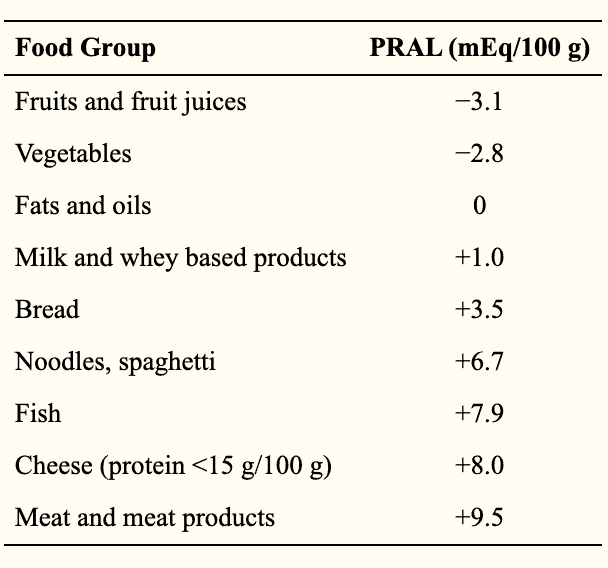
Conclusion
With the global escalation of processed foods, chemical additives, saturated fats, sugar, added salt, alcohol, airborne pollutants combined with our already stressful lives the toxic load is obvious. When the kidneys have become overloaded with dietary acid as we get older, and the lungs congested with mucous and pollutants the body will eventually become unable to cope with the acid load.
Combine this with a high level of stress and you have a recipe for disaster. What can we do?
What else can you do?
Drink plenty of water that has a neutral Ph and do lots of deep meditative breathing.
I always suggest completing a bi-annual Herbal DETOX Program which includes an alkaline diet plan.
If it’s weight loss you are looking to achieve then The Ultimate Herbal SLIM and Ultimate Herbal BodiTune can assist. They both include a whole food diet, which consists of mostly fresh fruits and vegetables.
Good luck with the next step on your health journey.



